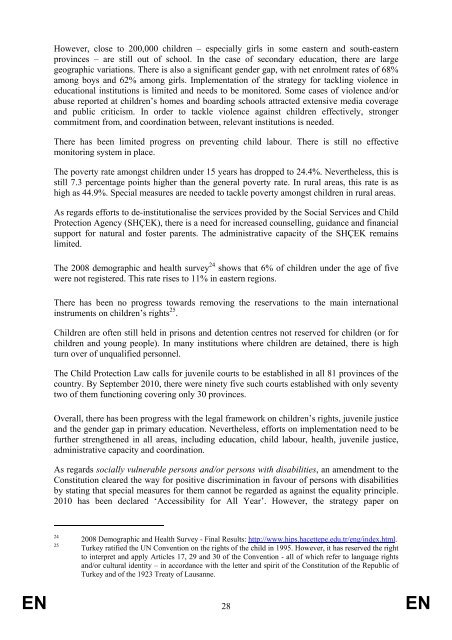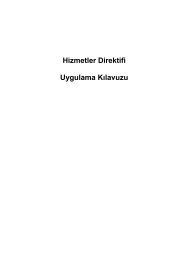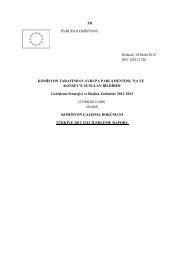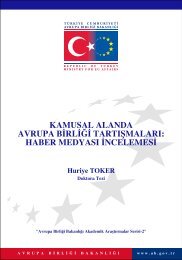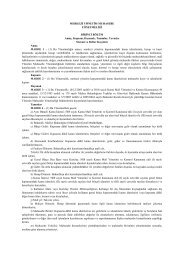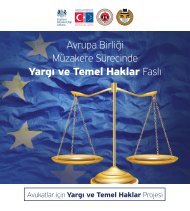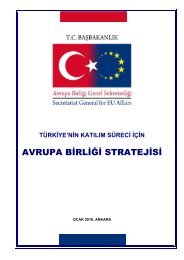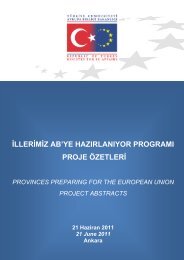2010 ilerleme raporu - Avrupa Birliği Bakanlığı
2010 ilerleme raporu - Avrupa Birliği Bakanlığı
2010 ilerleme raporu - Avrupa Birliği Bakanlığı
You also want an ePaper? Increase the reach of your titles
YUMPU automatically turns print PDFs into web optimized ePapers that Google loves.
However, close to 200,000 children – especially girls in some eastern and south-easternprovinces – are still out of school. In the case of secondary education, there are largegeographic variations. There is also a significant gender gap, with net enrolment rates of 68%among boys and 62% among girls. Implementation of the strategy for tackling violence ineducational institutions is limited and needs to be monitored. Some cases of violence and/orabuse reported at children’s homes and boarding schools attracted extensive media coverageand public criticism. In order to tackle violence against children effectively, strongercommitment from, and coordination between, relevant institutions is needed.There has been limited progress on preventing child labour. There is still no effectivemonitoring system in place.The poverty rate amongst children under 15 years has dropped to 24.4%. Nevertheless, this isstill 7.3 percentage points higher than the general poverty rate. In rural areas, this rate is ashigh as 44.9%. Special measures are needed to tackle poverty amongst children in rural areas.As regards efforts to de-institutionalise the services provided by the Social Services and ChildProtection Agency (SHÇEK), there is a need for increased counselling, guidance and financialsupport for natural and foster parents. The administrative capacity of the SHÇEK remainslimited.The 2008 demographic and health survey 24 shows that 6% of children under the age of fivewere not registered. This rate rises to 11% in eastern regions.There has been no progress towards removing the reservations to the main internationalinstruments on children’s rights 25 .Children are often still held in prisons and detention centres not reserved for children (or forchildren and young people). In many institutions where children are detained, there is highturn over of unqualified personnel.The Child Protection Law calls for juvenile courts to be established in all 81 provinces of thecountry. By September <strong>2010</strong>, there were ninety five such courts established with only seventytwo of them functioning covering only 30 provinces.Overall, there has been progress with the legal framework on children’s rights, juvenile justiceand the gender gap in primary education. Nevertheless, efforts on implementation need to befurther strengthened in all areas, including education, child labour, health, juvenile justice,administrative capacity and coordination.As regards socially vulnerable persons and/or persons with disabilities, an amendment to theConstitution cleared the way for positive discrimination in favour of persons with disabilitiesby stating that special measures for them cannot be regarded as against the equality principle.<strong>2010</strong> has been declared ‘Accessibility for All Year’. However, the strategy paper on24252008 Demographic and Health Survey - Final Results: http://www.hips.hacettepe.edu.tr/eng/index.html.Turkey ratified the UN Convention on the rights of the child in 1995. However, it has reserved the rightto interpret and apply Articles 17, 29 and 30 of the Convention - all of which refer to language rightsand/or cultural identity – in accordance with the letter and spirit of the Constitution of the Republic ofTurkey and of the 1923 Treaty of Lausanne.EN 28 EN


